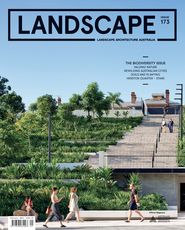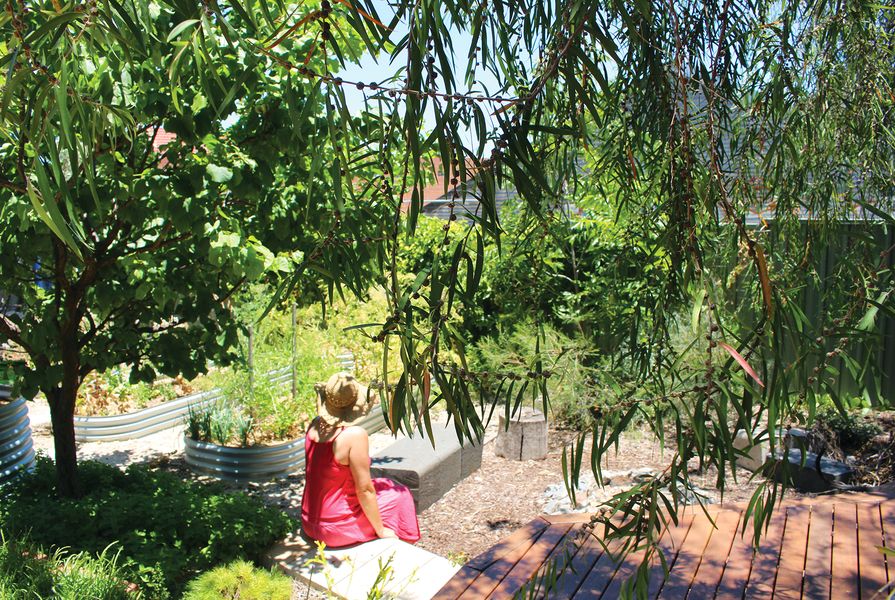Rosie Halsmith – Could you tell me about yourself, and how you came to be a landscape architect?
Christina Nicholson – I grew up in Western Australia’s Pilbara region – a subtropical, semi-arid environment where the landscape and climate dominated our lives. This landscape had a major influence on me. In the Pilbara, the connection between the plants, the climate and the landscape is extremely obvious. You can see this when you look at the spinifex – the way it forms and catches water, creating an air conditioner for the mice.
Christina Nicholson, founding director of Perth-based landscape architecture studio Banksia and Lime and lecturer at UWA School of Design.
Another influence would be my parents’ careers. My father worked in environmental protection as well as in support of Indigenous communities. My mother was a biologist and teacher. I was lucky to have a learning from both of my parents about the natural environment in my childhood – seeing both the macro and the micro scale.
The gardens I grew up in, both in the Pilbara and in North Fremantle, had a big impact on me. In Karratha, in the Pilbara, everyone else’s gardens had grass and palm trees, maybe frangipani and bougainvillea. In our garden, we had local native species and water-harvesting [systems]. Our garden in North Fremantle was completely dominated by mature tree species – both local and exotic. Every window had a view of a canopy.
The final influence would be the trauma and grief that my family and I went through in having a family member, my brother, with a mental illness that resulted in death. During my teenagerhood and young adulthood, my way of coping was to seek out natural landscapes.
Deciding to study landscape architecture completely made sense for me. My connection to nature, my understanding of the healing properties it has, and my love of families and community are all encompassed in the way that I practise.
A richly planted garden full of trees and banksias mostly native to south-western Australia elevates the daily routine at Banksia and Lime’s Ruby Street Garden.
Image: Daniel Marano
Planting lines the side of the house at Ruby St Garden, softening the passageway and spilling out onto the path.
Image: Daniel Marano
Could you tell me more about what the landscape architectural approach means at Banksia and Lime, and how this relates to design in the residential space?
Our philosophy is to connect people to nature in their everyday lives. It’s a biophilic approach – fostering a complete love of nature, with all its seasonal changes and its wildness.
Which strategies did you use to ensure good and biodiverse outcomes in your work at the Reed House Garden?
Thanks to a great brief, the garden lent itself to good biodiversity outcomes – and at Banksia and Lime, we can’t help but chuck in multiple species at a time.
The brief asked for a different garden for every room of the house, so we had a few different contexts to work with. This allowed us to have a lot of fun designing a number of different spaces with quite different species. We used seasonal colour to ensure there was a consistent overall connection – little clues from one garden to the next.
The garden at Reed House is experienced as a series of layers, with different garden rooms complementing the house’s individual rooms.
Image: Benjamin Hosking
Concept development sketches for Reed House Garden showing the various characters of the plantings.
Image: Christina Nicholson
How does social and ecological context play into the decisions you’re making for a residential space? How did this impact your design for Vine Street Garden – your own residential garden?
When we arrived at Vine Street, the front garden was 60 percent red concrete driveway. Our first response was to reduce the urban heat island effect. Together with my husband, who is an architect, we started up our orchard and added local, native species.
After the driveway was reduced, we kept the material on the property, rather than sending it to landfill – it’s used in our gabion walls.
I think that our front garden also belongs to the community – it’s a place to demonstrate and share ideas. So, we knocked down the front fence – we wanted people to think that they could pick an orange as they walked past. The fence has been replaced with a bench that you can sit on, and we’ve made sure there’s a flat surface on the top of our letterbox – a place for wine and cheese, or tea and biscuits. We’re out there often, and particularly during lockdown it was a very social space to be in.
Throughout the design and construction process, we would have neighbours come past and put in their two bob’s worth. Some of the best parts in the space are things our neighbours suggested.
Shallower than is usual and potentially unirrigated in the future, the Raglan Rooftop Garden is designed to be tough and resilient.
Image: Daniel Marano
What are the benefits of biodiverse design?
Having many local, native species within one garden means that you always have flowers, seasonal and daily change, and insects and animals coming in. A biodiverse garden creates interest, not to mention addressing the broader biodiversity loss emergency.
Biodiversity isn’t just about plants, it’s about the human interaction with the plants – about layering life with the little rituals that connect people to nature. At Vine Street Garden, our apricot tree is our outdoor Christmas tree – the summertime ritual. Our firepit is the birthday ritual for mid-year celebrations, surrounded by species that are flowering at that time.
The client for Reed House Garden has said to me that sometimes, when it’s quiet, she sits in a specific spot in the house, and looks across the central planted courtyard through to the backyard. That’s her favourite thing to do, to look at that layered view. To me, that’s golden. That’s what we need a landscape to do. It needs to provide that recharge moment, every day.
Biodiverse landscapes facilitate that moment to focus on yourself – to see the small, and then to connect to the broader systems that are working to make that small thing happen in your garden. From the micro to the macro. It’s healing to know that nature is still doing its thing.
Source

Practice
Published online: 2 Mar 2022
Words:
Rosie Halsmith
Images:
Benjamin Hosking,
Christina Nicholson,
Daniel Marano,
Daniel Marano.,
Sarah May
Issue
Landscape Architecture Australia, February 2022

























